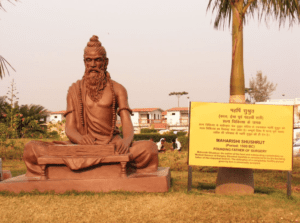Keerthana Kalla
Seattle, Washington, United States
 |
| Shushrut Statue In Patanjali Yogpeeth, Haridwar. Photo by Alokprasad. 2009. Via Wikimedia. CC BY-SA 3.0. |
The chronicle of medicine is the story of man’s struggle against illness. As early as 5000 BC, India developed a comprehensive form of healing called Ayurveda. Such traditional healing was first recorded between 4500 and 1600 BC. It is believed that sages were the early practitioners of Ayurveda around 2500 to 600 BC. They dedicated the practice to God and considered health an important part of human life. They advised on nutrition and used herbs according to a system of medical knowledge that formed the foundation of the practice.
Ayurvedic treatments have been documented in books for many generations. The knowledge was also orally transmitted but mostly written in palm-leaf manuscripts. Ayurvedic principles combine the elements of nature: “Vayu (air), Jala (water), Aakash (space), Prithvi (Earth), and Teja (fire). These five elements are known as the Pancha Mahaboota.”1 These elements of nature form the three basic principles of Vata, Pitta, and Kapha, mutually known as the Tridoshas. When the Tridoshas were imbalanced, they were believed to cause disease. Stability between the Tridoshas and the five natural elements resulted in a proper state of health.
There are two treatments in Ayurveda: purification therapy (Shodhana) and alleviating/palliative therapy (Shamana Chikitsa). Shodhana treatment annihilates dangerous doshas, which cause life-threatening illnesses. Shamana therapy follows Shodhana therapy and uses Ayurvedic medicines. Caraka Samhita, Astanga Hrdaya, and Sushruta Sahmita formed the eight branches of medicine in the fourth century BC. They were first described in an epic called Mahabharat and formalized over time as internal medicine, surgery, pediatrics, toxicology, purification of the reproductive organs, health/longevity, psychiatry/spiritual healing, and cosmetic surgery. These manuscripts are famous and still consulted in India today.
Although cosmetic surgery is a modern development, the origins date back more than 2500 years. During the sixth century BC, an Indian sage known as Sushruta—the “father of surgery”—documented more than 1,100 diseases, catalogued the use of various medical herbs, and wrote directives for performing surgical procedures including rhinoplasty and skin grafts.
Describing the surgical procedure of rhinoplasty in Sushruta Sahmita, Sushruta wrote: “The portion of the nose to be covered should be first measured with a leaf. Then a piece of skin of the required size should be dissected from the living skin of the cheek, and turned back to cover the nose, keeping a small pedicle attached to the cheek. The part of the nose to which the skin is to be attached should be made raw by cutting the nasal stump with a knife. The physician then should place the skin on the nose and stitch the two parts swiftly, keeping the skin properly elevated by inserting two tubes of castor-oil plant in the position of the nostrils, so that the new nose gets proper shape. The skin thus properly adjusted, it should then be sprinkled with a powder of liquor ice, red sandalwood and barberry plant. Finally, it should be covered with cotton, and clean sesame oil should be constantly applied. When the skin has united and granulated, if the nose is too short or long, the middle of the flap should be divided, and an endeavor made to enlarge or shorten the nose.”2 There are also citations that Sushruta molded false legs from iron, an early version of the technique known as prosthesis.
Sushruta documented the surgical tools used for specific procedures in the Sushruta Sahmita. He divided them into four plates, which describe hundreds of surgical tools including tongs, scalpels, catheters, probes, needles, specula, syringes, forceps, saws, and scissors. Most of his tools were made of steel and many are still used in a modern form by doctors today.
Like many other texts of ancient India, Sushruta Sahmita also traveled from India to other parts of the world and was translated to languages including Arabic, Latin, English, and Egyptian. Its wisdom is relevant today and it paved the way for the later development of science in India.
Medicine has changed considerably over the centuries. Technology today provides us with 3D-printed body parts, MRIs display malicious tumors, and medical remedies are produced in laboratories. Although none of this existed in ancient India, medics managed to treat patients using a natural system such as Ayurveda. Sushruta pioneered many operations and recorded them in his Sahmita, paving the way to modern medicine and science in India.
End Notes
- Ritu Sidgal, “Tracing the Modernization of Ayurveda,” ArcGIS StoryMaps (Esri, May 9, 2021), https://storymaps.arcgis.com/stories/0e91daad266a4dff99b5dbed0b307960.
- “Susruta Samhita: Ancient Indian Surgical Knowledge – National Council of Science Museums – GOOGLE Arts & Culture,” Google (Google), accessed August 20, 2021, https://artsandculture.google.com/exhibit/susruta-samhita-ancient-indian-surgical-knowledge-national-council-of-science-museums/8wKyx4LRDmyVKA?hl=en.
Bibliography
- “History of Medicine.” Encyclopædia Britannica. Encyclopædia Britannica, inc. Accessed August 20, 2021. https://www.britannica.com/science/history-of-medicine.
- Mark, Joshua J. “Sushruta.” World History Encyclopedia. World History Encyclopedia, August 20, 2021. https://www.worldhistory.org/sushruta/.
- Sidgal , Ritu. “Tracing the Modernization of Ayurveda.” ArcGIS StoryMaps. Esri, May 9, 2021. https://storymaps.arcgis.com/stories/0e91daad266a4dff99b5dbed0b307960.
- Singh, Vibha. “Sushruta: The Father of Surgery.” National journal of maxillofacial surgery. Medknow Publications & Media Pvt Ltd, 2017. https://www.ncbi.nlm.nih.gov/pmc/articles/PMC5512402/.
- Smith, D. B. “The Science of Ayurveda: Ancient Indian Medicine.” Science Abbey, May 29, 2018. https://www.scienceabbey.com/2017/12/10/the-science-of-ayurveda-ancient-indian-medicine/.
- “Susruta Samhita: Ancient Indian Surgical Knowledge – National Council of Science Museums – GOOGLE Arts & Culture.” Google. Google. Accessed August 20, 2021. https://artsandculture.google.com/exhibit/susruta-samhita-ancient-indian-surgical-knowledge-national-council-of-science-museums/8wKyx4LRDmyVKA?hl=en.
KEERTHANA KALLA is an 18-year-old Civil Engineering student at Seattle University. Born in India and raised in Seattle, she loves learning about literature and art history.
Highlighted in Frontispiece Volume 13, Issue 4 – Fall 2021

Leave a Reply